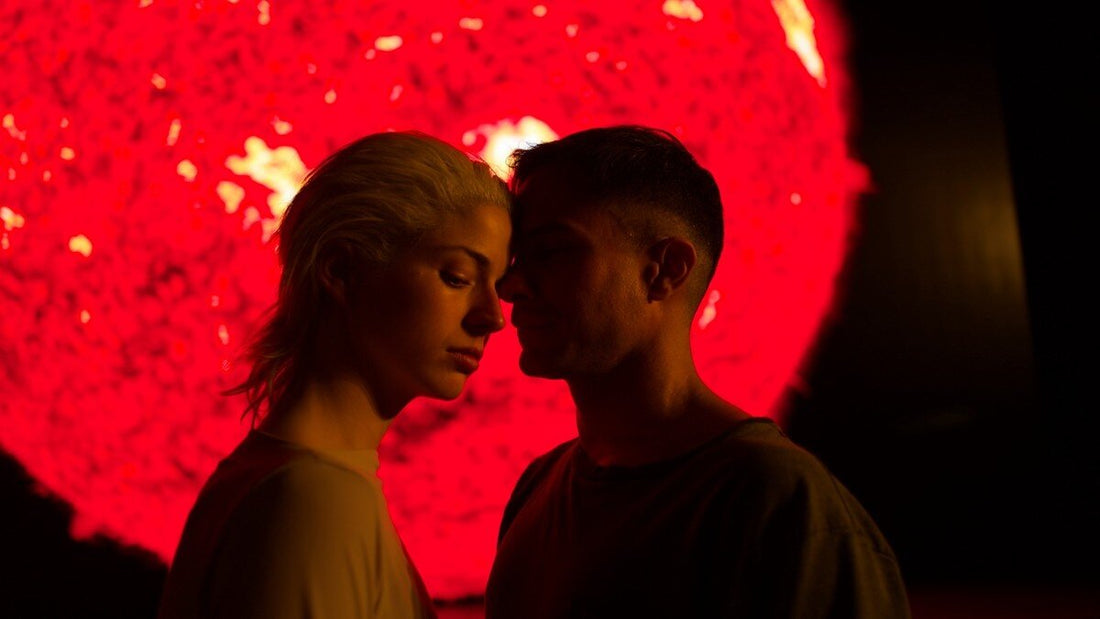With his incendiary feature Ema, Chilean director Pablo Larraín created a once-in-a-decade character. The eponymous woman is a mother, a dancer, a woman with a fractured personality conveying desire and frustration in challenging new ways: fluid, virile, unbridled, corrosive, hypnotic. Ariel Klinghoffer explores the incomparable character.
“I’m going to horrify you. When you know what I’m doing and why. You will be horrified.”
Red flags that masquerade as seductive remarks are not uncommon in Pablo Larraín’s 2019 Chilean feature, Ema. The titular character, played by Mariana di Girolamo, wears a tantalizing grin as she leans in close to her new target, Aníbal, to utter these words as the pair face each other on a bed, drenched in their hotel room’s green light. The power of Ema’s deceit is wrenched in the utter candidness of her words, underscoring how susceptible a man can be to a woman’s allure, when tenderly wrapped in her own self-proclaimed wickedness. This exchange in isolation is ubiquitous in cinema: a married man consents to cheating on his wife with a younger, eccentric, succubus-adjacent. However, the trope that has historically pigeonholed, demonised, and two-dimensionalised women is subverted here, as sex and domination are not the stakes with which Ema is working. Hers are much more horrifying.
Ema, a dancer in her early twenties, finds herself motherless and bound to a toxic, loveless marriage with Gastón, her dance troupe’s much older choreographer. After learning of Gastón’s infertility before the start of the film, the two adopt a seven-year-old boy from Colombia. Ema’s antics push her to seek catharsis in both dance and the art of flamethrowing (providing remarkable fiery visuals), and after watching the film countless times, I cannot decide if she does so to light up her world or watch it burn. At any rate, sharing this practice with her son leads him to inherit his mother’s combustive tendencies, and he accidentally starts a fire that melts off a sizable portion of Ema’s sister’s face. From there, Ema and Gaston return their son to the state’s custody, and once the mistake is realised, it is a) irreversible, and b) the beginning of Ema’s hypnotising cinematic fury.
Throughout the film, Ema walks a tightrope that is nearly tangible to the audience. Her diabolical plan to reclaim Polo as her son is opaque, and keeps the viewers wondering just how well she will manage to stay upright on the rope, without losing her footing. How does she plan on striking out with a victory? She wreaks havoc in her dance troupe, going against Gastón with the other dancers; she also weasels her way into a teaching position at Polo’s school after seducing the principal with her sapphic charm. The most vital of Ema’s schemes, however, is that in which she slithers her way into the marriage of Aníbal and Raquel from both ends – without either of them knowing about the other, as they are the new adoptive parents of Polo. Larraín never reveals the brainstorming in Ema’s mind, but the outcomes are plain to the viewer: starting a fire to draw Aníbal into her life (he is a firefighter), planning a divorce with her husband to become acquaintances with Raquel (she is a lawyer), and showing up at Polo’s school to throw herself into any position, just so that she can claim common ground with him. None of these extreme measures are acts of impulse, and they are not at all rash to Ema: she is calculating and anticipating the development of this bifurcated triangle scheme, all while maintaining full physical composure. Never does Ema’s guard waver, and where one might usually see the protagonist waxing in profound thought, it is replaced by a figure in full movement: Ema dances to set her life aflame with bravado.
Between group dance scenes with the gorgeous skyline of Valparaiso reflecting off the water, Ema slowly advances in the individual branches of her design, which include evenings at the bar that Aníbal tends, and dates with Raquel out by the port. What is more of a physical satiation with Aníbal is a slower burn love affair with Raquel; yet, in both cases, Ema’s seduction is upfront and feral, playing both on sensuality and boldness. In her games of seduction, Ema weaponises the seductive aspects of femininity, emulating a feline allure, with the precariousness of her charm intoxicating both partners. It is the very act of conjuring such aspects of her femininity that makes her so virile: Ema conducts pleasure in weaving a web tightly around Aníbal and Raquel that leaves them blind to reality – and Gastón is left completely in the dark. The corollary of Ema’s manipulations includes falling pregnant by Aníbal, and Raquel falling completely in love. And so when it comes to revealing the mise-en-scène of her actions, there is no way out for anyone.
On a macrocosmic level, while taking these corrupt, even cruel, elements into consideration, the greatest paradox of Ema lies in the purity of motherhood that Ema seeks. Her total destruction of every other relationship is not in vain, because conceptualising the prize is blinding enough for her to move forward, unrepentantly. The stakes of Ema’s story thrive on the interactive layers of her personality. The audience is presented with an image of both recklessness and wickedness that belong to a sorceress committed to the fluidity of her own movement, who commits atrocities with the unilateral objective of getting her son back. Her motives provide the perfect medium for desire, pain, and maternity to interact. Larraín uses the double-edged sword of Ema’s character to accentuate the infernal ferocity of motherhood; the power of her movement, in tandem with the manipulation of those around her, emphasises just how far she is willing to go to reclaim the only relationship not entangled in her chaos: Ema is more than willing to move mountains and renounce every drop of love to trial herself as deserving of Polo’s, portraying a form of contemporary sacrifice that could only be committed by the love of a mother. The depths that Ema goes to result in the perfect storm. In the final scenes, once she has taken Polo inadmissibly from school and returns him to Aníbal and Raquel’s home with Gastón cluelessly following her, the dust settles on the rocky terrain, and every character’s face is fixed with horror apart from Ema’s. Through our protagonist’s eyes, there is a happy ending.
Ariel (@qqnenfeu) is a bilingual Philly native transported across the Atlantic to France. She has degrees in Neuroscience and French, but is currently teaching English and experimenting with film, writing, and photography. She thinks films are activism, especially ones that construct the female gaze, and would trust her favorite filmmaker, Céline Sciamma with her life. Her favourite film is Portrait of a Lady on Fire, her favourite book is Normal People, and her favourite chocolate is Kinder Bueno white.



